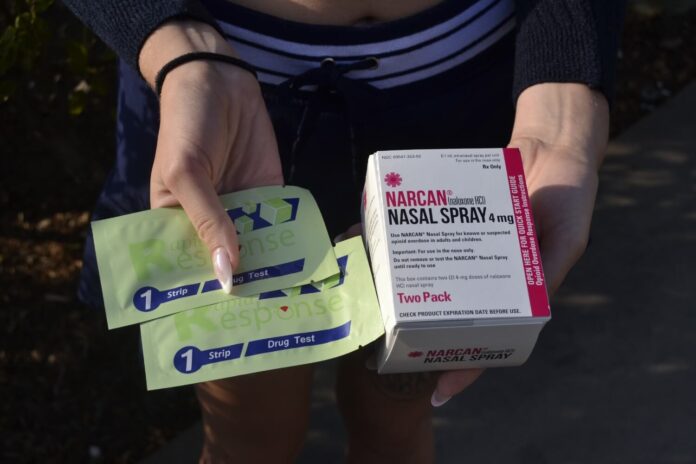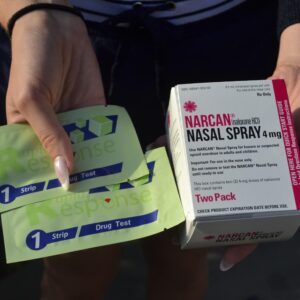
Drug overdose is one of the leading causes of death in Americans ages 18–45, according to Evelyn Chan, nurse practitioner at Emmons Wellness Center. Many overdoses are caused by drugs being laced with fentanyl, a powerful and dangerous synthetic opiate, Chan said. According to Director of Campus Safety Rick Tanksley, these concerns have reached the Occidental community and led the college to introduce policies providing Campus Safety and Emmons staff with Narcan — a nasal spray form of naloxone — which helps to reverse the effects of an opiate overdose. Naloxone is considered a safe medicine, and has no effect on those not taking opioids.
“People might think they’re using one thing, but then they could have a pill that’s laced with fentanyl and don’t know it,” Tanksley said. ”So the college wanted to be in a position whereby, since campus safety is the first responder to medical emergencies typically, we wanted to be in a position to render assistance immediately.”
Tanksley said an overdose on campus during the Spring 2022 semster spurred college action in instituting the use of Narcan.
“We could have lost two precious lives,” Tanksley said. “So we felt that we really need[ed] to act and come up with a plan.”
Richard Estrada, senior staff therapist at Emmons, said that he had worked with End Overdose at a previous job and put Devon Sakamoto, director of Emmons, in contact with the organization. End Overdose is a non profit dedicated to ending drug-related overdose deaths by offering free Narcan, training and education. Sakamoto worked to partner the school with End Overdose to provide Occidental with Narcan and fentanyl test strips, according to Estrada.
Grace Adler (sophomore) said she volunteered with End Overdose over the summer, and helped administer Narcan training to Emmons and Campus Safety staff. Adler said End Overdose emphasizes the importance of a peer-to-peer model of education at the college level, which aims to give students a comfortable space to open up.
“People are really afraid of getting in trouble,” Adler said. “Especially freshmen — they might not have used drugs or alcohol before. And what that does is it just creates isolation of people, and they don’t want to talk about it. And if you talk about it, you can be educated in a lot of things. A lot of people, for instance, will take a drug for the first time and like, won’t understand where they’re getting it from.”

Adler said that free training through End Overdose takes only about 15 minutes, and that participants receive free Narcan, which can otherwise cost around $130–$140 dollars for two doses. Adler said she plans to start an End Overdose club on campus, offering training and Narcan to students in a peer-to-peer instruction model.
Sakamoto said harm reduction policies, such as increasing availability of Narcan, fentanyl test strips and education about drug use is a more effective way of managing health concerns rather than strict anti-drug policies.
“It’s really about informing people about health risks, but also meeting them where they’re at,” Sakamoto said. “Obviously, we would prefer that nobody’s using drugs and alcohol — like, that’s the safest thing to do. But I think understanding the reality of the situation, that’s where our responsibility to their health and well-being comes in.”
While there are college and federal policies in place prohibiting the use of many substances, the goal of harm reduction policies like the medical amnesty policy and the educationally-focused student conduct process are to support students in need, according to Martha Matlock, associate director of Student Conduct & Restorative Practices. Matlock said that while the college reserves the right to refuse to grant medical amnesty for extenuating circumstances, the policy, which mitigates disciplinary actions for students or bystanders who proactively request medical assistance, is designed to promote student safety.
Matlock said the amnesty policy is designed to encourage students to call for help when needed without fear. Tanksley said students should never hesitate to immediately call the fire department and Campus Safety in the event of a medical emergency.
“In my opinion, the goal is not to punish a student for making a mistake, you know, and then compounding their horrible experience through some sort of punishment,” Tanksley said.
Sakamoto equated drug polices that do not include harm reduction measures to abstinence-only sex education: some people will still engage in these activities, and without harm reduction, they put themselves at unnecessary risk.
Estrada said harm reduction is about looking at drug use from a compassionate place and caring for those who use drugs as people first, rather than placing them under simplistic labels.
“What harm reduction means to me is the creation of safety through policies, practices and interventions for those who use substances versus the politicization and stigmatization that has historically been used to unfairly depict those persons who use substances,” Estrada said via email. “We live in a society that tends to pathologize certain substances or types of drug use and even certain demographics of persons who use substances, yet is the same society that is responsible for many of the conditions for why someone might use or turn to that substance.”

Baruch Goodman (senior), co-founder and president of the Occidental chapter of Students for Sensible Drug Policy (SSDP), said he discovered the organization due to his interests in researching mental health and mitigating drug misuse and addiction in relation to his cognitive science major. He said as he read into modern research, he immediately noticed gaps between the science and policy on drugs.
“I began to realize the true magnitude of the issue of drug legislation: our regulatory system had a complete disconnect from science as drug legislation has become a modern mechanism for the political powers of the U.S. to punitively target certain groups that used drugs instead of helping them solve their issues at the root,” Goodman said via email.
According to Estrada, it can be difficult for some people to accept the idea of harm reduction, because they see it as controversial or as enabling drug use. However, he said it is really about compassion, and understanding the reasons and intentions behind drug use.
According to Adler, education and an open conversation around drug use can prevent many needless deaths from drug overdoses, even at a relatively small scale like a college campus.
“The education and prevention part would just definitely help that and lessen those scenarios, because, you know, you’ll know how to try things safely,” Adler said. ”You’ll know the resources that you have, and you’ll know your rights and you’ll know exactly what you need to do. Another scary thing is that in those moments when you freeze and you don’t know what to do, I think it’s hard to understand that when someone’s overdosing, a life is on the line.”
Contact Mostyn Trudinger-Smith at mtrudingersm@oxy.edu.
![]()


































